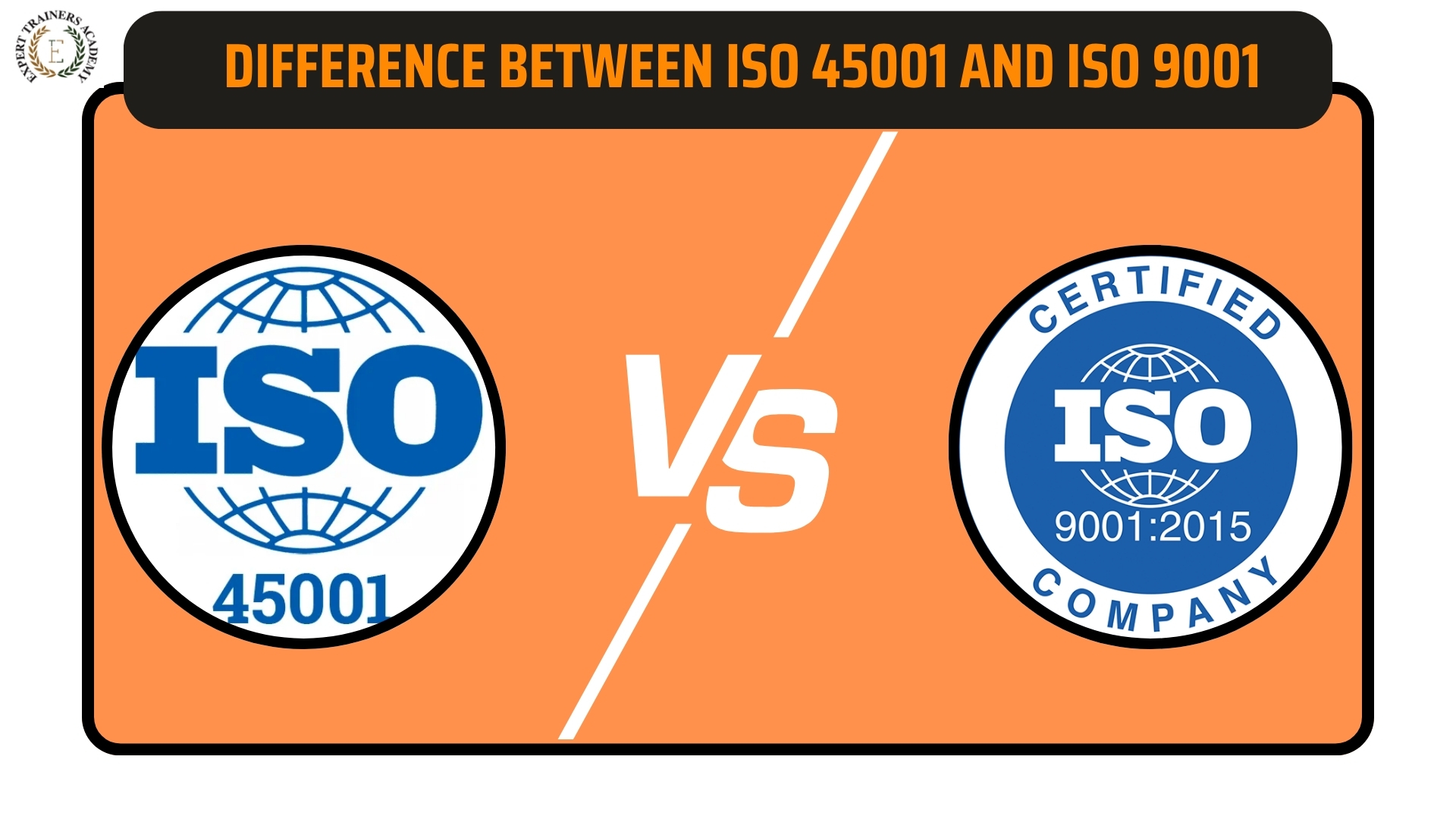
- Admin
- No Comments
- November 7, 2025
Running a successful business is not just about making profits — it’s about building trust, keeping people safe, and delivering quality every single time.
That’s where ISO standards come in. These are international rules that help businesses improve quality, safety, and efficiency.
Two of the most popular standards are ISO 45001 and ISO 9001.
Both are designed to make organizations stronger, but they focus on different goals.
- ISO 45001 is about health and safety at work.
- ISO 9001 is about quality and customer satisfaction.
Let’s understand the difference between ISO 45001 and ISO 9001 in simple words and see how both can help your business grow.
What Is ISO 9001? (Quality Management System)
ISO 9001 is a global standard that helps businesses make sure their products and services meet customer expectations.
It provides a clear system for managing quality, improving processes, and keeping customers happy.
In simple terms, ISO 9001 helps you do things the right way, every time.
Main Goals of ISO 9001
- Deliver consistent quality to customers.
- Improve company processes and efficiency.
- Build trust and confidence in your products or services.
- Encourage regular improvement in performance.
Key Features of ISO 9001
- Customer Focus: Understand what customers need and aim to exceed their expectations.
- Leadership: Management must support and promote quality across the organization.
- Process-Based Approach: Make sure every task follows a clear process.
- Continuous Improvement: Always look for ways to make things better.
- Fact-Based Decisions: Use data and results, not guesses, to make decisions.
Benefits of ISO 9001
- More satisfied customers
- Fewer mistakes and waste
- Better teamwork and communication
- Stronger reputation in the market
- Easier entry into new markets and contracts
ISO 9001 can be used by any type of organization — from small shops to large factories or service companies.
What Is ISO 45001? (Occupational Health and Safety Management System)
ISO 45001 is a global standard that focuses on employee health and safety.
Its main goal is to create a safe workplace by preventing accidents, injuries, and health issues.
When a company follows ISO 45001, it shows that it cares for its employees and follows proper safety rules and practices.
Main Goals of ISO 45001
- Prevent workplace accidents and injuries.
- Identify and reduce safety risks.
- Create a healthy and safe work culture.
- Ensure legal and safety compliance.
Key Features of ISO 45001
- Risk Identification: Find hazards before they cause harm.
- Worker Participation: Encourage employees to share safety ideas.
- Legal Compliance: Follow all safety laws and rules.
- Emergency Preparedness: Have a plan for emergencies.
- Monitoring and Improvement: Check regularly if safety measures are working
Benefits of ISO 45001
- Fewer workplace accidents and injuries
- Better employee confidence and morale
- Reduced downtime and costs
- Stronger safety image for your company
- Compliance with government safety laws
ISO 45001 applies to all industries, including construction, manufacturing, education, and healthcare.
Main Difference Between ISO 45001 and ISO 9001
Although both standards help organizations improve, they have different focuses.
Here’s a simple comparison to understand them better:
| Aspect | ISO 45001 | ISO 9001 |
|---|---|---|
| Focus Area | Employee health and safety | Product and service quality |
| Main Goal | Prevent accidents and promote safe work | Deliver consistent quality and customer satisfaction |
| Beneficiaries | Employees and workers | Customers and clients |
| Type of System | Occupational Health and Safety Management System | Quality Management System |
| Key Activities | Risk assessment, hazard control, safety training | Process improvement, customer feedback, product checks |
| Result | Safer workplace, fewer incidents | Better quality, more satisfied customers |
| Applicable To | All organizations with employees | All organizations that offer products or services |
In short,
ISO 45001 keeps your people safe,
ISO 9001 keeps your customers happy.
You Can Also Read: Integrated Management System ISO 9001 ISO 14001 ISO 45001
Similarities Between ISO 45001 and ISO 9001
Even though their purposes are different, ISO 45001 and ISO 9001 have many things in common.
International Standards:
Both are recognized worldwide and can be applied to any organization.High-Level Structure (HLS):
They follow a similar structure, making it easy to manage both together.Leadership and Teamwork:
Both require management involvement and employee participation.Risk-Based Thinking:
Each focuses on identifying and managing risks before problems occur.Continuous Improvement:
Both promote ongoing monitoring, review, and improvement of performance.
Because of these similarities, many organizations choose to combine ISO 45001 and ISO 9001 into a single integrated management system.
Can You Implement Both ISO 45001 and ISO 9001?
Yes!
Many successful businesses use both standards together.
While ISO 9001 helps improve quality and customer satisfaction, ISO 45001 focuses on health and safety.
Together, they create a complete system that builds a safe, efficient, and trusted workplace.
For example:
- ISO 9001 ensures the final product meets quality expectations.
- ISO 45001 ensures that the people making that product are safe and healthy.
When both systems work together, your company becomes stronger in every area — safety, quality, and reputation.
Which ISO Standard Should You Choose?
It depends on your company’s goals:
- If your aim is to improve product or service quality, go for ISO 9001.
- If your goal is to protect your workers and reduce risks, choose ISO 45001.
However, many organizations benefit most when they adopt both.
Together, they show that your business values people and quality equally, which builds long-term trust among employees, customers, and partners.
How to Get ISO 45001 or ISO 9001 Certification
Getting certified is a step-by-step process. Here’s a simple guide:
Learn About the Standard:
Understand the requirements and structure of the ISO standard you want.Gap Analysis:
Check where your company currently stands and what needs to be improved.Create a Management System:
Develop policies, processes, and documents that meet ISO requirements.Train Your Team:
Educate your staff so everyone understands their role in maintaining the system.Internal Audit:
Review your system to find and fix any issues before the official audit.External Audit (Certification Audit):
A certification body will assess your system. If everything meets the standard, you’ll receive your ISO certificate.Continuous Improvement:
Keep improving your system regularly to maintain your certification and grow your business.
Why ISO Certifications Matter
Getting ISO certified shows that your company is serious about quality, safety, and improvement.
It builds trust with customers, motivates employees, and strengthens your brand’s image in the market.
By meeting ISO standards, your business becomes more efficient, responsible, and globally competitive.
Conclusion
Both ISO 45001 and ISO 9001 are powerful tools for building a strong organization.
- ISO 45001 protects your employees by creating a safe and healthy workplace.
- ISO 9001 helps you deliver consistent quality and keep customers satisfied.
When used together, they form a complete system that improves safety, quality, and overall performance.
No matter your industry or size, adopting these ISO standards is an investment in your people, your customers, and your future success.
If you’re ready to learn more or start your ISO journey, connect with Expert Trainers Academy.
We provide professional training and guidance to help you achieve ISO certifications easily and effectively.
Frequently Asked Questions
Ans: ISO 45001 focuses on workplace health and safety, while ISO 9001 focuses on quality management and customer satisfaction.
Ans: Yes, many organizations implement both standards to ensure high-quality products and a safe work environment.
Ans: No, ISO 45001 certification is voluntary, but it helps businesses meet legal safety requirements and reduce accidents.
Ans: Customers and clients benefit the most, as ISO 9001 ensures consistent quality and reliable service.
Ans: ISO 45001 helps prevent workplace accidents, protects employees, and builds a strong safety culture in the organization.





